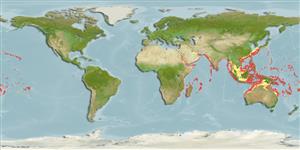Common names from other countries
分類 / Names
俗名 | 同種異名 | Catalog of Fishes(屬, 種) | ITIS | CoL | WoRMS | Cloffa
Teleostei >
Eupercaria/misc (Various families in series Eupercaria)
鱸形目 (Various families in series Eupercaria) >
Lutjanidae (Snappers)
笛鯛科 (Snappers) > Etelinae
Etymology: Pristipomoides: Greek, pristis = saw + Greek, poma, -atos = cover, operculum + Greek, oides = similar to (Ref. 45335).
More on author: Valenciennes.
Environment: milieu / climate zone / depth range / distribution range
生態學
海洋 底中水層性; 深度上下限 40 - 400 m (Ref. 11888), usually 180 - 270 m (Ref. 9821). 深水域; 35°N - 26°S, 31°E - 144°W (Ref. 55)
Indo-Pacific: East Africa to Hawaii and Tahiti, north to southern Japan, south to eastern Australia and Lord Howe Island.
印度-太平洋: 東非到夏威夷與大溪地島, 北至日本南部, 南至澳洲東部與羅得豪島。
Length at first maturity / 大小 / 重量 / 年齡
Maturity: Lm 52.0, range 37 - ? cm
Max length : 100.0 cm TL 雄魚/尚未辨別雌雄; (Ref. 5484); common length : 50.0 cm SL 雄魚/尚未辨別雌雄; (Ref. 9821); 最大體重: 8.2 kg (Ref. 4887); 最大年齡: 44 年 (Ref. 92301)
背棘 (總數) : 10; 背的軟條 (總數) : 11; 臀棘: 3; 臀鰭軟條: 8. This species is distinguished by the following characters: body elongate, laterally compressed; jaws about equal or lower jaw protruding slightly; premaxillae protrusible. maxilla extending to vertical through about anterior margin of pupil; upper and lower jaws both with an outer row of conical to small canine teeth and an inner band of villiform teeth, the caniniform teeth at anterior ends of jaws are not appreciably enlarged; teeth on vomer triangular patch, maxilla without scales or longitudinal ridges; interorbital region flattened. Gill rakers on first gill arch 7-8 + 15-18 = 22-26; last soft ray of both dorsal and anal fins well
produced, longer than next to last ray; caudal fin forked; pectoral fins long, about equal to or somewhat shorter than head length; membranes of dorsal and anal fins without scales; tubed
lateral-line scales 57-62. Colour variable, ranging from brownish to lavender or reddish
purple; snout and interorbital space with narrow yellow lines and blue spots often persisting as dark spots when preserved; dorsal and caudal fins light blue or lavender with reddish orange margins (Ref. 9821).
眼間隔平坦的。 下頜些微地伸出。 胸鰭長的, 達到肛門高度。 背鰭基底與臀鰭沒有鱗片,他們的最後軟鰭條在短的絲狀突起延伸了。 鱗片列背面平行於側線。 背面與側邊的顏色改變從褐色的對淡紫色或淡紅的紫色; 吻部與眼間隔有狹窄的黃線與藍色的斑點; 背鰭與尾鰭淺藍色或淡紫色的與橘紅色邊緣。
Adults occur over rocky bottoms (Ref. 30573); off Guam, caught most abundantly between 180 and 270 m (Ref. 9821). At night, they migrate vertically to the upper part of its habitat to feed (Ref. 11888). They feed on small fishes, shrimps, crabs, amphipods, ascidians and salps. Marketed fresh (Ref. 55). Caught mainly with bottom longlines and deep handlines, marketed main fresh and a good quality food fish (Ref. 9821).
生活在岩石底部之上;(參考文獻 30573) 外海的關島, 在 180 與 270 公尺之間捕獲量最大了。 (參考文獻 9821) 在晚上,它垂直地移動它的棲息地的到上半部覓食.(參考文獻 11888) 吃小魚,蝦,螃蟹,片腳類動物,海鞘類與被囊動物。 在市場上銷售生鮮地了。
Life cycle and mating behavior
Maturities | 繁殖 | Spawnings | Egg(s) | Fecundities | 仔魚
印度-太平洋: 東非到夏威夷與大溪地島, 北至日本南部, 南至澳洲東部與羅得豪島。
Allen, G.R., 1985. FAO Species Catalogue. Vol. 6. Snappers of the world. An annotated and illustrated catalogue of lutjanid species known to date. FAO Fish. Synop. 125(6):208 p. Rome: FAO. (Ref. 55)
CITES (Ref. 128078)
Not Evaluated
人類使用
漁業: 高經濟性; 游釣魚種: 是的
工具
特別的報告
下載 XML
網路資源
Estimates based on models
Preferred temperature (Ref.
115969): 12.2 - 22.6, mean 15 (based on 199 cells).
Phylogenetic diversity index (Ref.
82804): PD
50 = 0.5005 [Uniqueness, from 0.5 = low to 2.0 = high].
Bayesian length-weight: a=0.01072 (0.00753 - 0.01526), b=2.93 (2.83 - 3.03), in cm Total Length, based on LWR estimates for this species (Ref.
93245).
營養階層 (Ref.
69278): 4.2 ±0.4 se; based on diet studies.
回復力 (Ref.
120179): 中等的, 族群倍增時間最少 1.4 - 4.4年 (K=0.16-0.31; tmax=18).
Prior r = 0.58, 95% CL = 0.39 - 0.88, Based on 1 full stock assessment.
Fishing Vulnerability (Ref.
59153): Moderate vulnerability (43 of 100).
Climate Vulnerability (Ref.
125649): High to very high vulnerability (75 of 100).
